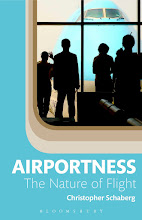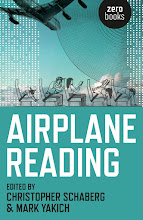Ten years ago, when I was a graduate student at UC Davis, I wrote a paper about the presidential airplane Air Force One. It was for a seminar on political theory, and I was considering this exceptional plane in light of Michel Foucault's writings on "governmentality"—or how methods and modes of rule get distributed and dispersed (in sometimes the smallest and seemingly most insignificant ways) throughout society and culture. I was actually looking less at the plane itself and more at a very curious ancillary text: the narrative "product description" for the plane that appeared for some time on the Boeing website. (It's gone now, replaced by a far more prosaic "overview" of the plane's features. But it was a fascinating text, revealing so much about the myths and fantasies embodied by this as-if self-evident aircraft.) I still have the transcript; here it is:
Air Force One Background Info
Air Force One is a Boeing 747-200B aircraft that was extensively modified to meet presidential requirements. The original paint scheme was designed at the request of President John F. Kennedy, who wanted the airplane to reflect the spirit of the national character. He also directed that the words "United States of America" appear prominently on the fuselage, and that the U.S. flag be painted on the vertical stabilizer.
Boeing delivered two uniquely modified Boeing 747-200 Air Force One presidential aircraft in 1990. The airplanes replaced the Boeing 707-320 airframe that had served the nation's chief executives for nearly 30 years.
U.S. presidents have flown on Boeing aircraft since 1943, when President Franklin D. Roosevelt flew to Casablanca aboard a Boeing model 314 Clipper. In 1962, U.S. presidents were provided modern jet transportation with the introduction of the Boeing model 707-320B, which was to become known by the radio call sign used when the president is aboard: Air Force One. In all, seven presidents were served by the 707-320B.
Today, the chief executive flies aboard a modified 747-200B, the newest and largest presidential airplane. The 747 is ideally suited to support the travel requirements of the president.
The Flying "Oval Office"
The 747s were built at the Boeing Everett, Wash., facility, then flown to the company's Wichita, Kan., facility for configuration as Air Force One. The aircraft were extensively modified to meet presidential requirements. The flying "Oval Office" has 4,000 square feet of interior floor space, which features a conference/dining room, quarters for the president and the first lady, and an office area for senior staff members.
Another office can be converted into a medical facility when required. There are work and rest areas for the presidential staff, media representatives and Air Force crews; two galleys are each capable of providing food for 50 people.
Lower lobes of the aircraft were modified to accommodate the airplane's self-contained air stairs and interior stairways that lead to the main deck. The lower lobes also feature unique storage to accommodate substantial amounts of food (up to 2,000 meals) and mission-related equipment. In addition, this area contains an automated self-contained cargo loader and additional electronics equipment.
About 238 miles of wire wind through the presidential carrier. This is more than twice the wiring found in a typical 747. Wiring is shielded to protect it from electromagnetic pulse, which is generated by a thermonuclear blast and interferes with electronic signals.
The airplane's mission communications system provides worldwide transmission and reception of normal and secure communications. The equipment includes 85 telephones, as well as multi-frequency radios for air-to-air, air-to-ground and satellite communications.
Air Force One provides longer range for presidential travel and can be self-sufficient at airports around the world. Modified for aerial refueling, it has virtually unlimited range.
Up to 70 passengers and 23 crew members can be accommodated, including necessary ground crew required to travel with the plane.
The 89th Presidential Airlift Group at Andrews Air Force Base, Md., is responsible for Air Force One, which is housed in a 140,000-square-foot maintenance and support complex at Andrews Air Force Base.















